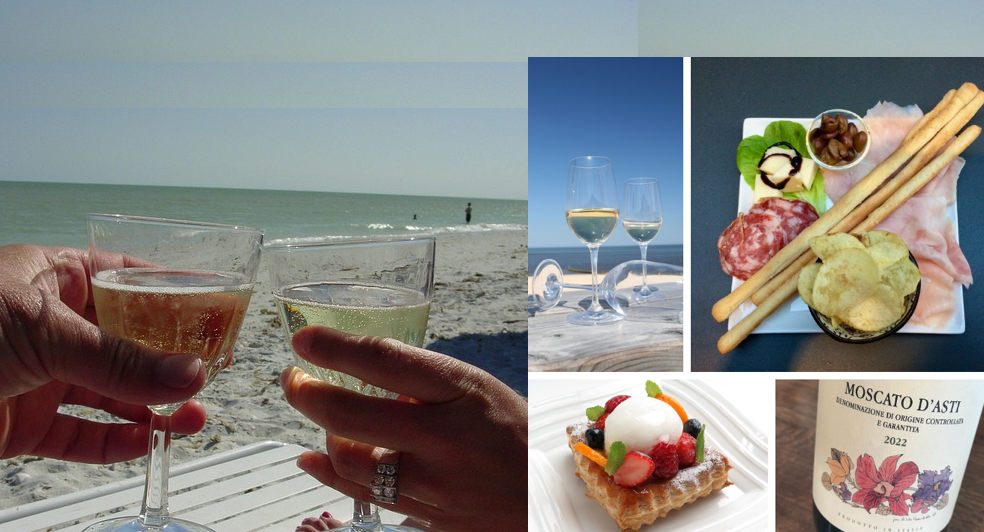Moscato d’Asti or Asti Spumante, Whats The Difference?
27th June 2023

Summer is coming! Time to enjoy a refreshing glass of sparkling wine on a terrace, at the beach, in your own backyard or balcony. Of course we all know Prosecco, Champagne and Cava, but have you ever thought of buying a sparkling Asti wine? Moscato d’Asti or Asti Spumante?
The namesake of both wines is the town of Asti in Piedmont, in the north-west of Italy. Both wines have the DOCG classification, but the wine law sets somewhat stricter requirements for the Moscato d’Asti than for the Asti Spumante. The moscato grapes, from which they are both made for 100%, may come from the provinces of Asti, Cuneo and Alessandria. The big difference is the alcohol content and the strength of the mousse. Asti Spumante has an alcohol content between 7 and 9.5% and Moscato d’Asti of up to 5.5%. The pressure is different as well. The pressure in Asti Spumante is between 3.5 and 4 atmospheres and the one in Moscato d’Asti is a maximum of 1.7 atmospheres. The bubbles in the first are therefore firmer.
Muselet or not
Asti Spumante is bottled with a ‘Champagne cork’, so with an iron muselet that prevents the cork from popping out of the bottle. That is not necessary with Moscato d’Asti: after all, the pressure is lower. If you see the two bottles next to each other, you could think the Asti Spumante is of a higher quality, because of the ‘Champagne cork’. However that is generally not the case. Moscato d’Asti is considered the superior version of the two. Less is made of it as well. Only the best, ripest grapes are used for this wine.
Moscato d’Asti, how it’s made
When the grapes are harvested they are immediately pressed. Then the juice is filtered and stored in a cool place. Fermentation is only done when there is a demand for the wine. This way the fresh and fruity flavours and aromas are best preserved. The fermentation takes place in a closed tank so that the carbon dioxide cannot escape and the wine gets its mousse. When the wine has reached 5.5% alcohol, the fermentation is stopped by cooling. Part of the sugars in the grapes have not yet fermented. This is how the Moscato gets its natural sweetness.
Asti Spumante, how it’s made
The amount of residual sugar in Asti Spumante is lower, but it often seems sweeter than the Moscato d’Asti. The main reason for that is the fact that great care is taken in the harvest and production so the sweet, sugary taste dominates the pronounced fruity Muscat character of the wine. The production method is different as well. Asti Spumante is made with the Charmat method. This means that, after the first fermentation, the wine undergoes a second fermentation in a sealed tank where the bubbles are created. The fermentation therefore takes longer than the fermentation of the Moscato d’Asti, which results in the lower residual sugar content.
What to eat with sparkling Asti wines?
Moscato d’Asti and Asti Spumante can both be enjoyed on many occasions and with different dishes. They are great with fresh summer fruit such as strawberries, blackberries and blueberries; with a soft or medium blue cheese like gorgonzola; with tarts and cakes with a fruity character; with Italian Cassata ice cream. But they are also delicious as an aperitif paired with some dried ham, olives and cheese. Or serve them at a festive Sunday brunch. Or just on a sultry summer evening! And, because of the low alcohol content, both wines are also great as a festive breakfast wine!
Something sweet to end the story…
After an extensive dinner or a cozy barbecue with friends, a glass of wine with your dessert? A refreshing glass of Moscato d’Asti or Asti Spumante is highly recommended! The mousse is invigorating and an additional advantage is that they have a much lower alcohol content than most other dessert wines. And that might be a good idea if you already had some drinks during your dinner.
![]()
Anne-Wies van Oosten, DipWSET
Dutch wine journalist, currently living in Transylvania, Romania, from where she travels the world and publishes articles about Wine, Food & Travel on her platform www.anne-wies.nl
